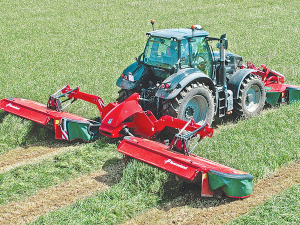Kverneland to debut Alentix fertiliser spreaders at Agritechnica
With Agritechnica just around the corner, it’s no surprise to see manufacturers drip-feed some information of new products worth a closer look.
 The rotors are smaller in diameter, helping promote a more efficient pick up and even distribution of the crop.
The rotors are smaller in diameter, helping promote a more efficient pick up and even distribution of the crop.
Recently launched and likely to be an indent-only machine for New Zealand, Kverneland’s new 15.6 metre tedder is aimed at increased productivity and timeliness.
Spreading grass, whether for hay or silage, might appear a simple task, and traditionally it was, but as crops have got heavier and tractors more powerful, there has had to come a new approach to the design of the machines to do so.
At close to 16m wide, the Kverneland 85156 C has been designed and manufactured to deal with increasingly heavier crops and higher horsepower tractors, with special attention to the forces created by leverage from the outer extremities of the tedder back into the main frame.
With strength and durability comes bigger section steel and more weight, so the decision was made to use a trailed format, which in turn makes a wide machine easier to fold tightly behind the tractor for transport between jobs.
At more than 50 feet wide, the design brief also had to incorporate adaptability over undulating ground, in both fore-and-aft and side-to-side situations.
The result is what Kverneland calls the TerraFlow linkage, which connects the main boom to the frame’s axle using two short linkages that impart tractive effort to the boom, as well as a hinge point for adjusting rotor angles. The latter is achieved using a single hydraulic ram, while also lifting the rotors out of work at the headland.
The TerraFlow design works across the whole machine, effectively creating a flexible boom that allows each of the 14 rotors to follow ground undulations.
The rotors are smaller in diameter, which Kverneland suggests helps promote a more efficient pick up and even distribution of the crop, as well as helping to separate the stalks as they are “hit” by a greater number of tines as the tedder moves across the paddock, which is also said to reduce “leaf shatter” in fragile crops.
In the field, the crop is left in a consistent blanket across the full working width, although those operators looking to leave material slightly ridged – perhaps to reduce dew penetration or to allow wind to pass through rather than over the tedded material – are also catered for by reducing the rotor speed.
The layout sees the main ram altering the rotor angle and lifting them out of work, while secondary rams activated by sequential valves fold the rotor boom and lower it onto a cradle for transport.
Kverneland suggests a tractor of around 150hp to handle the machine, allowing speeds of up to 12km/h, to deliver a work rate of 8-10ha an hour.
In other news, the company has also added two butterfly mower conditioners to its range, with the introduction of the 5387MT and 5395MT models, initially for European markets. Fitting between the 5087MT and 53100MT Vario to offer a wider choice, both models can be fitted with BX swath groupers.
The 5387MT uses a pair of 3.2m eight-disc beds, the 5395MT uses 3.6m nine-disc beds, and both feature round cutting discs carrying twin ProFit quick-change blades. Based on the 3300-series mower platform, the machines offer fixed cutting widths of 8.75m and 9.5m respectively.
Incorporating Kverneland’s own QuattroLink bed suspension system, a multi-link mechanism allows up to 700mm of vertical and 30 degrees of transverse movement. Kverneland claims that by using a pulltype suspension, each bed can react to demanding ground conditions – even at high forward speeds – while a non-stop safety break-back mechanism across the full working width helps avoid impact damage.
For the conditioning units, steel, semi-swing type tines combine with an adjustable conditioning plate to alter the conditioning intensity across a wide range of crops.
Machine control is achieved via in-cab switchboxes, said to be easy to set up and allow a wide range of adjustments to be made on the move.
The addition of the optional BX belt-type swath grouper to either machine allows the full cutting width to be placed into a large single swath.
Legal controls on the movement of fruits and vegetables are now in place in Auckland’s Mt Roskill suburb, says Biosecurity New Zealand Commissioner North Mike Inglis.
Arable growers worried that some weeds in their crops may have developed herbicide resistance can now get the suspected plants tested for free.
Fruit growers and exporters are worried following the discovery of a male Queensland fruit fly in Auckland this week.
Dairy prices have jumped in the overnight Global Dairy Trade (GDT) auction, breaking a five-month negative streak.
Alliance Group chief executive Willie Wiese is leaving the company after three years in the role.
A booklet produced in 2025 by the Rotoiti 15 trust, Department of Conservation and Scion – now part of the Bioeconomy Science Institute – aims to help people identify insect pests and diseases.
President Donald Trump’s decision to impose tariffs on imports into the US is doing good things for global trade, according…
Seen a giant cheese roll rolling along Southland’s roads?